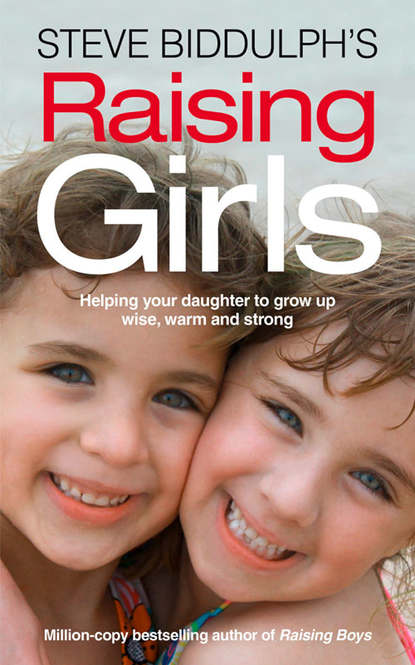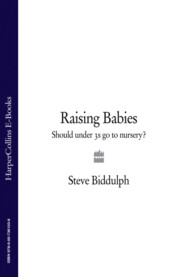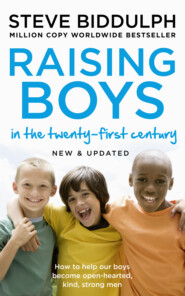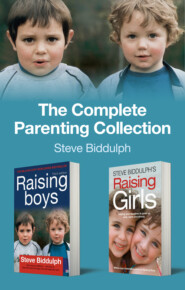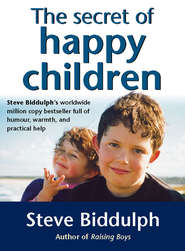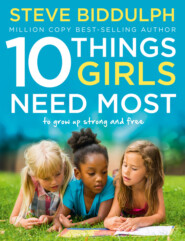По всем вопросам обращайтесь на: info@litportal.ru
(©) 2003-2024.
✖
Steve Biddulph’s Raising Girls
Автор
Год написания книги
2018
Настройки чтения
Размер шрифта
Высота строк
Поля
Does this matter? Well, it’s long been known that even though girls are equally able at maths, most boys enjoy maths more and go further with this subject at school, and further into those careers that need some maths (which includes a lot of the best-paid jobs). Girls are often quite frightened by maths. (And to be honest, some girls are frightened by scary male maths teachers, of whom there seemed to be a lot, at least when we were kids.)
I am sure that no parent ever sets out to disadvantage their girls around useful number skills, yet we unconsciously start making the boys practical and the girls emotionally focused.
So here’s a suggestion, perhaps we ought to reverse this. Girls are well wired for being emotionally aware; we can encourage that, but we can also spice our chatter to them with lots of number stuff. ‘How many rabbits can you see?’ And our boys are already wired for spatial knowledge, so ‘those rabbits are nervous, look, they’ve stuck their ears up to listen for us’ can get them thinking about feelings. No need to get obsessive about it, I am willing to make a bet that just reading this has already got you thinking about what you say.
Talk to your toddler daughter about numbers, and counting, and praise her for good engineering with her Lego bricks. Don’t ever assume ‘girls don’t …’ anything, because they can, and they will, if we believe and encourage them early on. Sally Ride, the first American woman astronaut, dedicated her life after space to getting girls to study science. It creates more opportunities for them and doubles the talent pool of good scientists, which we definitely need.
Enthusiastic Learning
Because learning and fun are the same thing for a happy child, in the years from one to five your daughter will do more self-educating than thousands of pounds in school fees could ever buy for her later on. It’s very sad when parents are too busy earning in the toddler years to have time to play and do things with their littlies. And it’s pretty tragic if when those kids actually get to school, the love of exploring has died inside them.
Kids learn to love life and learning from the adults around them. On top of their natural curiosity, they will also follow ours and catch our enthusiasm. Watch an experienced mother or father on a bus with a toddler and you will see that they point things out to them with feeling. If you are excited (or even pretend to be, just a little) she will catch your mood.
SECURITY LEADS TO EXPLORING
Though your little girl is no longer a baby, that doesn’t mean she is over the ‘Am I loved and safe?’ stuff. In fact this still applies just as much. The reason is that secure toddlers explore the most. The very first experiments in child development, carried out by people like John Bowlby and the amazing explorer/researcher Mary Ainsworth, found that babies who are ‘securely attached’ (i.e. love and trust their mum or dad to be there) are the ones who go further and are more adventurous.8 (#litres_trial_promo) Toddlers who are not trusting of their parent or carer to be there for them will cling more and be less willing to go and play with a new toy or a new playmate. (Don’t feel bad if your toddler is still clingy, though, as there is also a fair bit of temperament in this, some toddlers just are more cautious than others.)
What makes them most secure is knowing that you are always around for them.
So they can take that as a given, and spend their emotional energies on new excitements. If they are already anxious about life, new things are just too much to handle.
Think for a minute about your attitude to insects, bugs or nature in the raw. If you say ‘Ick, horrible ants, aargh, get away!’ then of course your daughter will be scared of them too. But if you say ‘wow, have a look at this …’ she will catch your attitude. It doesn’t mean she should poke into spider’s nests or pick up death adders, but you can teach her a sensible interest and she will be fascinated for the rest of her life.
It’s the same with machines, the insides of cars and computers, garden sheds, tools and making stuff, craft work, music making, art and sculpture, cooking, dancing, loving being in the forest or at the beach, these are all ‘caught’ from grown-ups around you.
Lots of Arty Stuff Is Free
The best learning aids for your one-to-five-year-old daughter are simple and cheap. Not fancy ‘educational’ toys or gadgets which provide all the action with batteries or flashing lights; the simpler, plainer and tougher, the better.
Arty kinds of activities are encouraged by having lots of recycled paper to hand, along with an abundant supply of pencils, crayons and paints. Cardboard boxes, egg cartons, old greeting cards and paper catalogues all lend themselves to creative playing and don’t cost a penny. You can build up a considerable supply of creative materials in reserve for a rainy day or quiet time each day, and bringing out something new starts the process all over again.
But here’s a hint – be sure to get these tidied away and orderly after each session, and get your daughter’s help to do this. Then it’s encouraging to start each new play session without having to wade through yesterday’s mess. You can also alternate; crayons one day, paints the next, glue and tearing up coloured paper another, so there is more sense of new adventures to be had.
A SIMPLE ENVIRONMENT IS BEST
There is an important principle, discovered by psychologist Kim Payne, author of the wonderful book Simplicity Parenting,9 (#litres_trial_promo) which is that a clutter of toys and materials actually makes for less play – it’s all too much choice – whereas a few simple things, in a box ready for getting out, leaves more scope for imagination. If your child’s bedroom is already awash with toys, quietly take away the less favourite ones, bag or box them, for use another time. When your daughter looks at a sea of teddies, dolls, games and bits of creation cascading all over the floor or all over her room, she feels the way you do – exhausted. And really, does anyone need more than two teddies? Well, okay, three.
Clothes
Girls should have plenty of old and tough clothes so they can be messy and happy in the dirt, or doing art activities with paint, water and glue and not freaking out about getting it on themselves or their clothes. In fact, little girls don’t need fragile or fancy clothes at all. Those fashionable frilly numbers really have no purpose for little girls except to make them anxious about how they look. Fashion on children is for the adults’ benefit, and if your child doesn’t look cute enough already in a t-shirt and rompers, then you need to read fewer magazines. (There is nothing sadder than seeing a toddler dressed in such prissy and ‘feminine’ clothing that she can’t do anything but sit and be ‘good’.)
One mum told me recently: ‘I used to say to my toddler daughter, “That dress looks gorgeous” or “How pretty you look.” But I have started to say: “Let’s put on these strong trainers (or wellies) so you can run and play.”’
MATILDA LEARNS NOT TO BE FEARFUL
(This story was told to me by my psychotherapy teacher, Bob Goulding, at the Western Institute in the 1980s. Bob was the grandfather in the story. He was a wonderful man.)
Two-year-old Matilda was enjoying playing around the swimming pool, carefully watched by her mum and grandparents. She would play happily in the toddler pool, but from time to time she would wander across to the deeper pool for a closer look. Suddenly, she simply stepped from the edge and completely disappeared into the deep water. Her grandfather, fortunately wearing some old shorts, jumped straight after her. He grabbed Matilda immediately and pulled her out. Matilda, still utterly surprised, screwed up her face and was clearly about to start wailing. But before that could happen, her granddad did an interesting thing. Holding her at arm’s length, he shouted ‘Wow! Matilda swims! What a great swimmer she is! You are great!’ while laughing and looking very pleased. Matilda seemed to hesitate, look at him for a puzzled moment – he was hard to ignore – then she did a remarkable thing. She simply changed her face to a big smile, and joined in the laughter.
Her mum came and took over, carrying Matilda back into the water and played with her, anchoring the experience into a positive one.
Would this turn Matilda into a risk taker? We don’t think so, it was scary enough to have taken that sudden plunge, but it would have taught her that adventures can be taken on the chin, and it’s better to laugh than cry. In her brain the pathways towards quick recovery and resilience were beginning to be put in place.
If we didn’t have pool fences, it might make sense to terrify kids about water. (Aboriginal parenting traditionally involved terrifying children about monsters that lurked beyond the firelight at nighttime, because it was important they didn’t stray. In my Yorkshire childhood we were half-laughingly warned about the Bogey Man.) Helping our daughters to see life as an adventure and to be confident in their own skills and judgement is important because it means they can live a larger life. These will be the girls who scuba dive, volunteer for Médecins Sans Frontières, learn to pilot a plane, or play gypsy violin in an indie rock band. Although, I am trying to talk you into this!
If Matilda’s mum or dad had freaked out, started yelling and carrying on, after Matilda’s unexpected dip, this little girl would have added to her own already considerable startle that the parental message was that water is scary. She may well have become phobic of water and swimming itself as a result. ‘Hell’s bells’, she thinks, ‘even Mum and Dad are terrified!’
The direct teaching that her grandfather offered – ‘look here, this is fun!’ – can be applied to many things in life, and from a very early age. We can help our daughters to be comfortable with animals, nature, climbing, books and libraries, sporting exertions, people, the night sky, the ocean, the list goes on. And they will carry this love of the world into their lives forever. Whenever you show her a new experience, you can add some enthusiasm, some ‘Hey look – isn’t this great?’, so that she also takes in a positive message.
Be sensible about it, but see if you can extend your daughter’s boundaries every chance you get.
Nature Is Essential
A garden with real plants and soil, water, and maybe some trees is great. A rough cubby house (or even a big cardboard box) creates a base to play from and in. Gardens naturally come equipped with insects, lizards and birds, though you can perhaps still add an old safe dog.
Girls need a chance to move around in nature. If you live in a block of flats or have no garden, get to the park, countryside or coast whenever you get the chance. Let them experience the rough textures and long-distance views, as toddler eyes need to look long distances and absorb natural sunlight to develop good vision. Running about on uneven surfaces will also make their legs flexible and strong. The sheer mystery of what’s behind that bush or tall grass will help their imaginations too.
Computers, iPads and DVDs have their place, but for small children through to teens these electronic devices can warp the senses and affect brain development negatively, because they are all flat and clean and the same distance away. You don’t refocus your eyes or move about enough to develop the balance and activity centres of the brain. And you don’t really feel love and connection to an animal on a screen in the same way as something you can touch and hug.
Three Should Be Free
With girls of age three or four, the goal and need of her brain is to play, to not be pressured and to be able to be creative and free. These qualities will one day make her a great scientist, boss, artist, problem-solver or friend. She will always want to and be able to ‘do her own thing’. But if she is made to perform – by a pre-school with ‘early learning goals’, or a parent who wants her to play violin, or some activity that grooms and preens her for adult consumption (participating in child beauty contests is a stunningly awful example), then she will not develop properly, will be cramped and tense and lack creativity. Whole nations have experienced this through over-demanding schooling for the under-sixes. The result is a total lack of creativity, a population that is cowed, conformist and compliant. By six or seven, a girl is ready for some (not too much) serious learning imposed from the outside. Her brain has moved on to a whole different stage. If it comes too soon, though, it actually harms her intellect, and her eventual ability to be talented and bright.
So think twice about structured or organised activities that involve any kind of performance or competition. These just take the joy out of something she would otherwise have loved. Activities where all the kids simply get into it together and learn happily at their own pace are much preferred.
A final note – the two to five years are exhausting, and you can be a bit isolated. Don’t think you have to be an education ringmaster for your kids all day. They need to occupy themselves, dream and dawdle as their imagination grows. It’s in the gaps and quiet times that children do their growing. Turn off TVs and radios so they can think and talk internally, which they love and need to do as they play.
Don’t let yourself get lonely, either. Join a playgroup, where the kids start to have fun with others, and YOU get to be with other mums or dads (there are dads’ playgroups too now). Also learn to be boring sometimes and encourage your kids to just play around and without you while you merge into the furniture. You need your rest.
Choosing Toys
If you have heard ANYTHING about getting girls off to a good start, it’s probably been about ‘gender-stereotyped toys’. The role of toys in widening, or limiting, your little girl’s play choices is a huge thing, and you’d think by now companies would have really got past this. But here’s the bad news: it’s getting worse. Companies never give up on trying to hook kids and parents with heavy marketing – especially on TV, where toys can be made to look so much better than they really are.
This article is by Paula Joye, a journalist and fashion columnist, website publisher and a very sensible mum. I couldn’t put it better …
Role Model or Pole Model?, by Paula Joye
My youngest daughter is five and spent the weekend penning a Christmas Wish List to Santa. Nestled between a backpack shaped like a koala and a detective magnifying glass is a request for a Bratz Masquerade toy. She saw it advertised while watching Finding Nemo on television. The doll is dressed in an outfit that would look great wrapped around a pole. She has swishy, knee-length hair with pastel streaks, hoop earrings and more black kohl eyeliner than a Kardashian.
I’m a little stuck because we don’t have any Bratz in our house. I’m not sure exactly what I don’t like about them. I loathe the lollipop heads and cushion pouts. Hate the heavy make-up. But I think what upsets me the most is their wardrobes. Seriously, these dolls wrote the rules on Red Light. A toy designed for five- to 10-year-old girls shouldn’t be so overtly sexy. Pretty, geeky, smart, ugly are all fine but scantily clad dolls should be reserved for lonely grown men who can’t get real girlfriends.
For me the message is just too narrow. The Bratz brand is 13 years old, which means the original crash-test consumers are just starting to flex their fashion chops. On the weekend, I watched some of these girls heading into the Eminem concert in Sydney. They were wearing clothes that defy description. Mainly because there was so little fabric covering their bodies that I’m struggling to come up with words other than naked and nude to describe how they looked. This is the first batch of young women to have been influenced by a society hell bent on fast-tracking them into womanhood and the first place we’re going to see the results is in the fashion choices they make. What struck me more than the bare skin was how homogenised their look was. Everyone was dressed identically. It was a sea of tiny, cut-off denim shorts and fluro crop tops. Teenagers have always copied one another – it’s normal to dress the same way as your friends – but there used to be so much more diversity and self-expression. I remember copying the wardrobes of Madonna, Wendy James and Diane Keaton at the same age. I experimented all the time. But there was none of that in this crowd. It was Same. Same. Sexy. Same.
We can’t blame this on Bratz or Barbie alone – there are so many influences that play on young girls – but it does make you despondent about the serious lack of role models both on the toy shelf and in the mainstream. Once they wave bye-bye to Dora and Angelina the choices are whittled down to Bindi Irwin, Harry Potter’s Hermione and a couple of exceptions on Nickelodeon. Otherwise it’s Miley, Taylor, Selena and The Biebs. Where are Pippi Longstocking and Nancy Drew? Why isn’t there a Kate Winslet for Tweens?
It would be so easy for me to capitulate on the Bratz present. Seeing her little face light up when she opens it on Christmas morning is a tempting trade. But every time I teeter, I close my eyes and visualise her dressing the doll up in its miniature thigh-high boots, a micro-mini skirt and green boob tube and … well, I want more.
More imagination from the toy manufacturer, more depth from the doll and frankly a little bit more fabric for my money.





